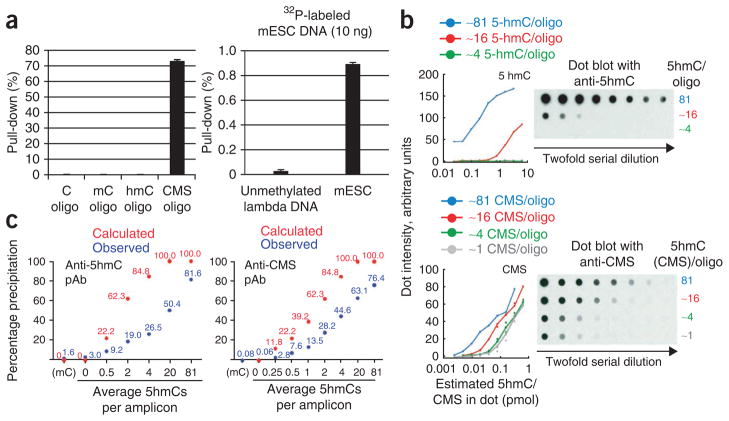Figure 2.
Testing antibody specificity and comparing the density dependence of anti-5hmC and anti-CMS methods. (a) Left, cytosine-, 5mC-, 5hmC- or CMS-containing oligonucleotides (201 bp) were 32P-end-labeled and precipitated with the CMS-specific antibody. The IP efficiency was measured by counting the radioactivity in the IP material. Right, unmethylated lambda and mESC genomic DNA were sheared to 200 bp and end-labeled with 32P. Genomic DNA was subsequently precipitated with the CMS-specific antibody. IP efficiency was measured as described above. Error bars show s.d. (n = 3). (b) Density dependence of 5hmC-specific and CMS-specific antisera demonstrated using the dot-blot method. Twofold dilutions of a 201-bp oligonucleotide with different densities of 5hmC were spotted on a nitrocellulose membrane. The data were plotted as dot-blot intensity normalized to the total amount of 5hmC in the spot (i.e., 1 pmol of an oligonucleotide in which all 81 cytosines are replaced with 5hmC contains 81 pmol 5hmC, equivalent to 5 pmol of an oligonucleotide generated with a 20:80 mixture of 5hmC:C, which contains ~16 5hmC on average). Top, anti-5hmC dotblot. Bottom, anti-CMS dotblot. (c) Precipitation of 5hmC-containing DNA fragments via anti-CMS IP and anti-5hmC IP. PCR amplicons (201 bp, 81 cytosines) that contained varying amounts of 5hmC were bisulfite-converted or left untreated, 32P-end-labeled and precipitated using the appropriate method. The data shown in this figure are reproduced with permission from refs. 22 and 27. pAb, polyclonal antibody.

